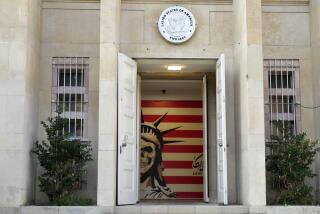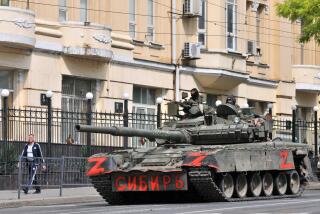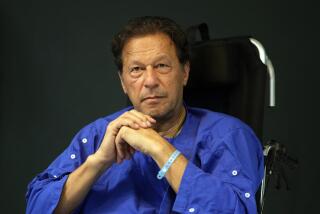Extremists Fundamentally Altering Pakistan’s Culture
- Share via
Military coups d’etat in Pakistan are not unusual. Indeed, in its 52-year history, it has frequently seen such military takeovers, often because of social and political uncertainty after a humiliating defeat. Thus the Indo-Pakistan war of 1971--which resulted in Pakistan’s partition and the creation of Bangladesh--led in time to Zulfikar Ali Bhutto’s demise and the coming to power of Gen. Zia ul-Haq in 1977.
External factors and influences have also contributed to bringing the military to power and to keeping it there. During the Cold War, the West believed that Pakistan’s military rulers were more trustworthy than civilians and a more stable barrier to Soviet designs. This was certainly true during the Afghan War and the U.S.-Pakistan alliance against Soviet invasion.
Even after Soviet withdrawal from Afghanistan and restoration of civilian rule in Pakistan, the military played an important role in determining Islamabad’s Afghan policy and, at least since 1993-94, there has been a convergence of U.S. and Pakistani interests in Afghanistan. Only recently has the U.S. become alerted to the dangers that this policy poses to its own interests and to Pakistan’s future.
The latest coup also takes place at a time of great social and political stress, especially the growing fragmentation of Pakistani society along sectarian lines. This polarization also comes amid longer-standing regional, ethnic and linguistic divisions; economic difficulties; the executive leadership’s increasing authoritarian tendencies and the alarming growth of militant and extremist religious groups, which has led to sectarian violence. Added stresses have been the recent Indo-Pakistani clash in the Kashmir region and what many Pakistanis saw as a humiliating withdrawal in the face of Western pressure.
What makes this latest coup truly different--and its ramifications for Pakistan and Southwest Asia difficult to predict--is the fundamental cultural, social and political changes that Pakistan has been undergoing. Two developments have been critical.
First has been the steady Islamization of Pakistan, according to a strict and less-progressive interpretation of Sunni Islam than the nation’s fathers had in mind.
This began in earnest with Zia and, ironically, was not stopped by his secular successors. Benazir Bhutto, in her first term from 1988-90, tried to resist but soon discovered that the new forces were too strong to be ignored. Then she herself tried to use them to bolster her position, most notably against Nawaz Sharif. During her second term, from 1993-96, Bhutto made an alliance with one of the least progressive Islamic groups, the Jamiat-ulema-e-Islam, and took the first steps toward creating the Taliban in Afghanistan. When he took power, Sharif further advanced this process by getting the National Assembly in 1998 to amend Pakistan’s constitution to establish the rule of Sharia, or Islamic law. At one point, Sharif even expressed admiration for Taliban-style justice--quick and harsh--and said that a similar attitude in Pakistan might be the only way to stop its crime and violence.
The second development has been the transformation of Pakistani Islam into a less tolerant, more puritanical and less progressive system of belief. This stemmed from the growth of ideas inspired by the ultraconservative Wahabi Islamic sect based in Saudi Arabia, from the Iranian revolution and from the Afghan War. The concern is that adherents of this particular version of Islam are found within Pakistan’s bureaucracy and even its military.
The outcome of these developments is increased intolerance toward religious minorities, and especially the Shiites, who represent as much as 20% of Pakistan’s 150 million people, and the growth of extremist groups, some of them armed.
Most of these extremist groups are Sunni, but a few exist among the Shiites as well. However, the Shiites have been more victims of violence than its initiators, and they have complained that various Pakistani governments have not seriously pursued and punished the anti-Shiite extremists. Indeed, the rise of the Taliban to power in Afghanistan in the last two years has strengthened Pakistan’s anti-Shiite groups.
Yet as long as extremist Sunnis directed their wrath against Pakistan’s Shiites or were used as tools in the twin strategies of containing Iran and advancing Pakistan’s strategic goals in Afghanistan and Central Asia--which coincided with Western policy--not much attention was paid to them.
Only after last year’s terrorist attacks against U.S. embassies in Kenya and Tanzania, followed by this year’s march by Pakistani militants into Indian-held territory in the Kashmir region, did the risks involved in this fundamental transformation of Pakistan’s culture attract outside attention and raise fears of an Islamic revolution. Some observers, in fact, argued that the choice in Pakistan was between military rule and Islamic revolution. The worst nightmare, of course, is a military-ruled government with Islamist sympathies and now endowed with nuclear weapons.
So the issue in Pakistan is not simply military rule versus democracy--if the latter ever existed--but rather that of a society facing serious religious and cultural cleavages, in addition to its more traditional divisions along ethnic and linguistic lines.
Pakistan is not alone in facing this predicament. India, Iran, Turkey and Afghanistan are also torn by similar religious and cultural dichotomies and clashes.
That does not augur well for stable evolution in this important but conflicted region.
More to Read
Sign up for Essential California
The most important California stories and recommendations in your inbox every morning.
You may occasionally receive promotional content from the Los Angeles Times.













